
Maintaining and accessing medical records is crucial in healthcare. These documents track a patient's medical history and treatments, ensuring continuity of care, supporting research, and meeting legal standards. However, a common question among newer medical professionals is, "What is the shelf-life of medical records?"
The answer is not a simple one, as it depends on various factors. Let's explore the sanctity of medical record shelf life and provide key insights on how to navigate the complexities effectively.
Why “Shelf Life” Speaks Volumes in Healthcare
The idea that medical records have a “shelf life” highlights the necessity of keeping them in a condition that preserves their informational and legal significance. Like how a manufacturer's warranty has an expiration date, medical records also have a set period of efficacy, after which they can be discarded or deemed no longer valid for certain purposes.
In healthcare, the concept of information perishability is complex and multifaceted. A record that is crucial and legally significant today may become irrelevant if it is not regularly updated, securely stored, or maintained in compliance with regulatory standards.
The Legal and Ethical Timelines Governing Records
Figuring out how long to keep a medical record can feel like walking through a legal minefield. It's important to follow the Health Insurance Portability and Accountability Act (HIPAA) rules, along with other laws. These rules tell you the least amount of time you have to keep different kinds of records, often for many years after a patient's last visit or treatment.
For example, HIPAA requires hospitals to keep adult records for six years after the last visit and children's records until the patient turns 21. Not following these rules can result in significant fines and damage to your reputation.
Best Practices for Ensuring Protection of Medical Records
Proactive measures are crucial in maintaining the security of medical records. Keeping your records safe and easily accessible is the first line of defense. Here are some simple tips to help you manage your documents better and keep them safe:
- Regularly check and get rid of records you don't need but be careful not to throw away important files.
- Organize your medical records and use smart storage systems, such as color-coded file labels or electronic medical record software, to make them easily accessible.
- Make sure you can get your records back quickly and safely if you need to.
- Train your team on how to handle records correctly to avoid mistakes.
- Keep your digital records safe from hackers and disasters by having strong security software.
By implementing best practices in medical record management and utilizing reliable storage solutions like medical chart holders, healthcare providers can ensure that medical records retain their value and purpose throughout their shelf life.
A medical record is more than just storing information; it's about keeping track of a patient's health story and the work of healthcare providers. Understanding the shelf life of medical records can help improve healthcare services, help providers follow the rules more closely, and help them be safer.





